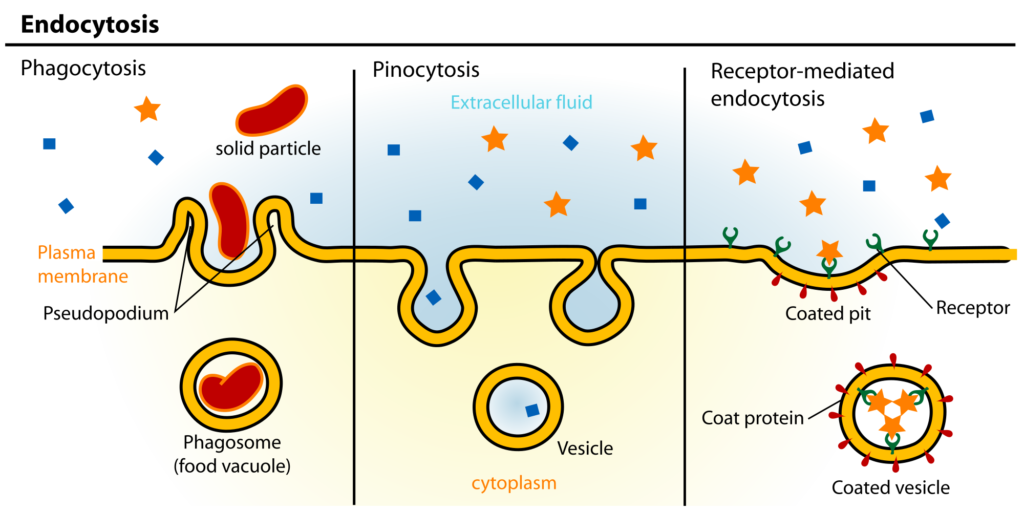Receptor-mediated endocytosis (RME) is a form of endocytosis in which specific molecules and macromolecules are taken into the cell by binding to receptor proteins. It is an energy-dependent process that involves vesicles, and it has been implicated in many important cellular processes such as nutrient uptake, signal transduction, intracellular cholesterol transport, and regulation of cell growth.
In RME, receptor proteins on the surface of a cell bind to specific molecules or macromolecules outside the cell in order to take them into the cell. The internalized cargo is then contained inside vesicles formed from the plasma membrane. These vesicles fuse with lysosomes which degrade the cargo, enabling transport of the molecules or macromolecules inside the cell.

RME can be divided into two sub-types: clathrin-mediated endocytosis (CME) and caveolae-mediated endocytosis (CvME). In CME, clathrin proteins form a basket-like structure on the plasma membrane and engulf the molecules or macromolecules to be internalized. CvME occurs through caveolae, which are small pits or invaginations in the plasma membrane that contain specialized proteins. These proteins enable the molecules or macromolecules to enter directly into the cell without being contained by a vesicle.
RME plays an important role in many areas of cell biology, particularly in signal transduction and drug delivery. It is also involved in the uptake of substances necessary for normal cellular functioning, such as cholesterol and proteins. Additionally, RME is important for the removal of toxins from the body by allowing cells to take up and degrade potentially harmful molecules or macromolecules.
Types of Endocytosis
Phagocytosis
Phagocytosis is a type of endocytosis in which cells take in large particles or organisms, such as bacteria and foreign materials. Phagocytes are specialized cells that engulf the particles or organisms using pseudopods (temporary extensions from the cell membrane). The engulfed material then becomes enclosed within vesicles inside the cell. These vesicles then fuse with lysosomes, which contain enzymes that degrade the engulfed material.
Pinocytosis
Pinocytosis is another type of endocytosis in which cells take in small particles such as nutrients and ions from the extracellular fluid. The cell membrane invaginates to form a vesicle around the particle, which then fuses with lysosomes for degradation. Pinocytosis allows cells to take up essential molecules without using energy, making it an important process in many cells. learn more about local meditation by clicking here
Protein Trafficking in Endocytosis
The internalization of proteins into cells is an essential process for maintaining cellular homeostasis. Endocytosis plays a major role in this process, as it allows the cell to take up particular proteins and regulate their levels within the cell. This process involves receptors on the plasma membrane that bind to specific proteins outside the cell, which are then engulfed by vesicles. These vesicles then fuse with lysosomes, which degrade the proteins and enable their uptake into the cell. This process is essential for regulating the levels of certain proteins in cells, as well as for transporting them to other parts of the cell or out of the cell.
Endocytosis is an important process that mediates a wide variety of cellular processes, from nutrient uptake to protein trafficking. It is a highly regulated and energy-dependent process that allows cells to internalize molecules and macromolecules from their environment and regulate their levels inside the cell. By understanding how endocytosis works, scientists can gain insight into many important biological processes.
Endocytosis is also becoming increasingly important in drug delivery, as it can be used to target drugs specifically to their desired location inside the body. Ongoing research is exploring how endocytosis can be manipulated and exploited for therapeutic purposes, such as delivering cancer therapies directly to tumor cells. With further advances in our understanding of this process, endocytosis may become a useful tool for improving treatments and delivering medications.
Final Words
Endocytosis plays an essential role in many cellular processes and is becoming increasingly important in drug delivery. It is a highly regulated, energy-dependent process that allows cells to take up molecules from their environment or transport proteins to different parts of the cell or outside the cell. With further advances in our understanding of endocytosis, it may become an invaluable tool for improving treatments and delivering medications.
References:
- Rink, J., & Palmer, A. E. (2005). Endocytosis. Cell, 122(6), 767–774. https://doi.org/10.1016/j.cell.2005.09.004
- Watson, P., & Vaughan, O. (2016). Endocytosis and trafficking: the ABCs of protein uptake and intracellular mobility. Frontiers in Cell and Developmental Biology, 4, 57. https://doi.org/10.3389/fcell.2016.00057
- Thompson, M., Gannagé-Yared, M.-H., & Chemaly, R. (2014). Endocytosis: an important pathway for drug delivery. Trends in Molecular Medicine, 20(1), 45–53. https://doi.org/10.1016/j.molmed.2013.09.004

